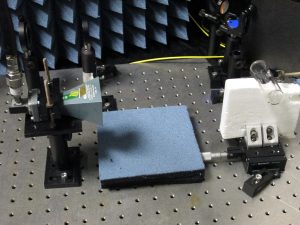Scientists have released new theoretical and experimental work that suggests an innovative method using optical wavelengths to overcome certain restrictions on electric field evaluation.
Current methods of mapping electric fields at radio frequencies employ certain metallic structures such as dipoles, probes and reference antennas. These structures, however, must be roughly the same size as the wavelength of the RF fields to be mapped in order for the measurements to be successful, a requirement that places limitations on the smallest features that can be measured.
A new study from researchers at the National Institute of Standards and Technology and the University of Michigan instead poses the idea of using laser light at optical wavelengths to measure and image RF fields. The technique utilizes a pair of highly stable lasers and rubidium atoms as tunable resonators to map and potentially image electric fields at resolutions below their RF wavelengths, but above wavelengths of the lasers.
Using their new experimental setup, NIST and Michigan researchers were able to map field strength as a function of position at resolutions as low as one-hundredth of an RF wavelength, far below normal antenna limits. In theory, the technique should even work for wavelengths ranging from 600 to 300,000 micrometers.
The achievement is expected to assist scientists with explaining the behavior of metamaterials and metasurfaces, artificial structures that exhibit electromagnetic properties not found in nature. Furthermore, the ability to image with sub-RF wavelength resolution could help designers optimize properties of closely-packaged electronics and lead to the development of new microscopy systems and imaging sensors.

According to an NIST press release, the rubidium atoms in the experiment are contained within a hollow glass cylinder, which is illuminated at both ends by red and blue laser beams that act as a stimulant and filter, respectively. As the cylinder moves along a track, the atoms inside are excited by the red laser and subsequently absorb all the light. Then, a tunable blue laser excites the atoms further to one of the many possible higher energy (“Rydberg”) states, which exhibit unique properties such as extreme sensitivity to electromagnetic fields.
Next, an RF field at the frequency to be mapped or imaged is generated by the antenna. This field affects the frequency at which the atoms vibrate, or resonate, altering the frequencies at which the atoms absorb the red light. According to the researchers, this change in absorption can be easily measured and is directly related to the electric field strength at the portion of the cylinder affected by the lasers.
The new imaging technique is part of an ongoing NIST effort to develop a method that will, for the first time, directly link electric field measurements to the International System of Units (SI).
The study, “Sub-Wavelength Imaging and Field Mapping via EIT and Autler-Townes Splitting In Rydberg Atoms,” is published in the journal Applied Physics Letters. The involved NIST researchers developed the new measurement and imaging technique, while the University of Michigan participants provided the tunable blue laser and assisted in the measurements.
The project is funded in part by the Defense Advanced Research Projects Agency.





